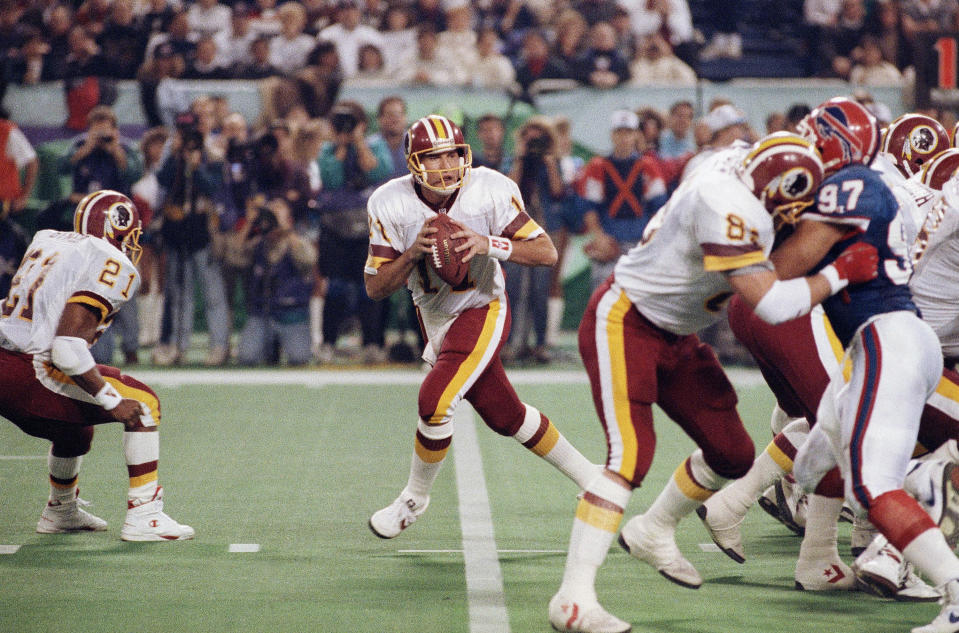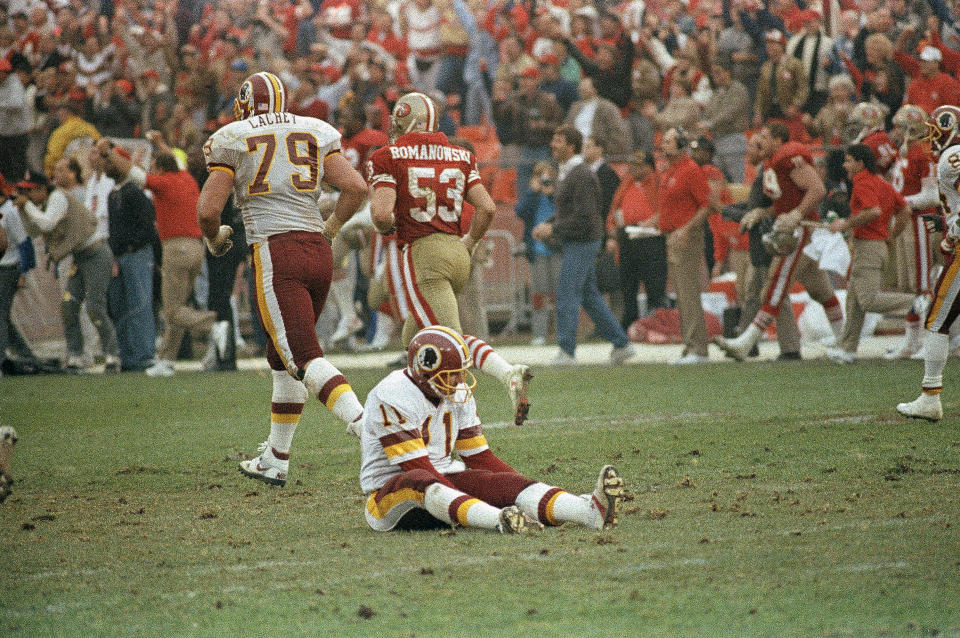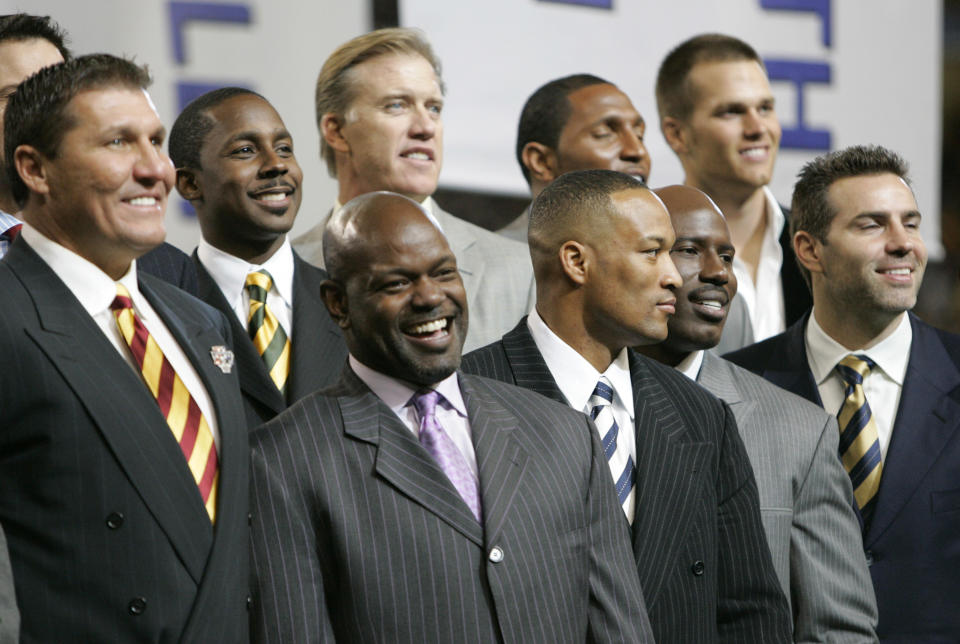Mark Rypien's Super Bowl legacy goes from triumph, to tragedy, to triumph again
MINNEAPOLIS – Mark Rypien was a special quarterback for one season, and only one season.
The only other time the Super Bowl was played in Minnesota, Rypien finished a season that is unlike any other in NFL history. In 1992, Rypien’s Washington Redskins beat the Buffalo Bills, 37-24. Rypien was the MVP of Super Bowl XXVI.
It’s not exactly fair to call Rypien a one-year wonder. He made a Pro Bowl in 1989, as an injury replacement when Joe Montana and Don Majkowski were hurt. He had a solid run of success from 1988-90. But nothing else in his career approached what he did that 1991 season.
Other players have had exactly one great season in the NFL. Washington had one later on named Robert Griffin III, for example. We’ve seen Super Bowl heroes come and go quickly. Timmy Smith, anyone? But nobody through the history of Super Bowl MVPs has put together a full, great season like Rypien had, and never again reached that level of success before or after. Rypien was one of the best players in football in 1991, and won a title. By 1994 he wasn’t even a starter in the league anymore.

That Super Bowl changed his life in ways we all could guess.
“You can’t write your name, sign an autograph, without writing ‘Super Bowl XXVI MVP,’” Rypien said.
It also changed his life in ways he never could have predicted. He is now consumed with the Rypien Foundation, which helps children with cancer and their families. He’s the group’s chairman, and has helped it grow to fantastic success. It had a net revenue of more than $921,000 in 2015, according to tax returns. It became his life’s mission after losing his 3-year-old son Andrew to cancer in 1998.
Rypien understands that the one great day he had at the Metrodome so many years ago isn’t simply one reason his foundation has been able to help thousands of kids battling cancer.
“It’s the only reason,” Rypien said.
*****
Rypien’s 1991 season didn’t come out of nowhere, but close. His first three seasons as a starter, he had 37 interceptions in 33 games. He was considered too mistake-prone for the Redskins to win big. Late in training camp in 1991 there was still a lingering question about whether Rypien would hold off Stan Humphries for the starting job.
“We thought he was good,” said NFL Network analyst Charley Casserly, who was in Washington’s front office from 1977-99 and was general manager of the 1991 team. “Did we think he was elite? In all honestly, he hadn’t done it enough to think that.”
The 1991 season was a perfect convergence, for Rypien and the team. The Redskins had great players – Jim Lachey, Charles Mann, Art Monk, Darrell Green. Gary Clark, Mark Schlereth and Joe Jacoby among them – but it was a team defined by depth. There were no real weaknesses.
“I think Joe Gibbs said it’s the easiest season he had,” Casserly said. “The players were prepared to work every day.”
Washington started the season beating Detroit 45-0, which was the largest win in team history. The Redskins began the regular season 11-0, and finished 14-2. Their two losses were by five combined points. The Redskins won their playoff games by 17, 31 and 13 points. They had 12 wins by double digits and nine wins by at least 20 points. You don’t often see that level of domination in the NFL.
Football Outsiders’ advanced stats rank the 1991 Redskins as the greatest team of the past 30 years by a landslide. In 2016 USA Today ranked the 1991 Redskins as the greatest Super Bowl champion.
“The science and the numbers and the stats say we were the best team and it wasn’t close,” Rypien said. “So we have that to hang our hats on.”
Rypien threw for 3,564 yards and 28 touchdowns, both of which led the NFC. Rypien’s strength was throwing the deep ball, and he did so with amazing accuracy that season. His 8.19 net yards per attempt is seventh-best in a single season all time, and the top six spots are occupied by some of the most iconic quarterback seasons in NFL history. Rypien got eight MVP votes. He finished fourth behind Thurman Thomas, Jim Kelly and Barry Sanders, three cinch Pro Football Hall of Famers.
“He couldn’t do anything wrong,” Casserly said.
A dream season culminated in Minneapolis. The Redskins crushed a Bills team that was great in its own right. Washington was just better. Rypien had 292 yards and two touchdowns. His deep passes were deadly, as usual. Rypien was named Super Bowl MVP, and it was well deserved. When the game was over he was picked for a then-famous commercial and yelled into the camera, “We’re going to Disneyland!” It was a most fitting end to his fairy-tale season.
Perhaps Rypien was in the right place at the right time. He had a world-class offensive line that allowed nine sacks in 19 games, a great running game, three fine receivers in Monk, Clark and Ricky Sanders, and a Hall-of-Fame coach in Gibbs. But don’t call his 1991 season a fluke. Rypien had a great season, from the blowout of Detroit in the opener through the Super Bowl.
“We all played the best when it mattered most,” Rypien said. “I do also say, I played at a high level when it mattered most. That’s when I get some self-satisfaction.”
And then, perhaps just as improbably as he emerged as a star, Rypien’s reign as a top quarterback vanished almost overnight.

*****
Rypien was just 29 years old when he reached the top of the NFL world. And after that season, he never came close to that level again. Rypien had a 97.9 rating in 1991, and a 67.7 rating after. He spent just two more poor seasons as a starter before settling in as a backup with four different teams. It’s a unique football tale.
In 1992 Rypien got a then-team record three-year, $9 million deal after holding out, but his season itself was frustrating with 13 touchdowns, 17 interceptions and a 9-7 record. Then Gibbs retired. In 1993 the Redskins went to the West Coast offense, a scheme that accentuated short passes. That was all the rage in the NFL, but it did not fit Rypien’s strengths.
The Redskins dominated the eventual Super Bowl champion Cowboys to start the 1993 season, but Rypien tore his meniscus in his knee the following week. He was supposed to be out 8-10 weeks. But with his team 1-3, Rypien came back after missing just two games. When he’s asked if he looks back on his career with any regret, that’s what he mentions.
“I felt for my guys. I wanted to come back so I came back early,” Rypien said. “I wasn’t 100 percent. I saw my guys struggling and there was a loyalty to them.”
On one good leg, Rypien was awful after he returned. He threw one touchdown to 10 interceptions in his final 10 games before hurting his knee again. Washington went 4-12. Less than two full years after leading an incredible team to a dominant Super Bowl win, Rypien was done as the Redskins’ starter – the team cut Rypien after he refused a pay cut and drafted Heath Shuler third overall a few months later – and he would never be a regular starter in the NFL again. He was just 31 years old, and labeled as a backup.
“It could have been the holdout, it could have been the injuries, and our team was not as good,” Casserly said in explaining Rypien’s fade. “Maybe defenses caught up to what he did with the deep balls. It was probably a combination of everything.”
Mostly, Rypien focuses on the positives. He had one unbelievable season. Most players don’t get that.
“I don’t know he has any regrets, because he’s humble enough to say, ‘I had an opportunity and I won a Super Bowl MVP,’” said Steve Rector, his childhood friend and the president of the Rypien Foundation. “Certainly he’s not disappointed about anything. He knows he had a unique opportunity and he took full advantage of it.”
Perhaps the way Rypien’s football career went after 1991 doesn’t bother him because he dealt with something far more devastating off the field.
*****
Rypien’s career log has a strange gap. He settled in as a backup with the Browns, Rams, Eagles and then back to the Rams from 1994-97. Then he was out of football for three years before a final hurrah as Peyton Manning’s backup with the Colts in 2001.
That gap is because he left the game in 1998. His 3-year-old son Andrew died after a battle with brain cancer that August.
“After that, I didn’t know exactly the fog I was in, and not having a compass in life and not giving a [expletive] about life,” Rypien said. “I didn’t know if I cared about life at all anymore.”
It wasn’t until he was brought the idea of starting a foundation to help children with cancer and their families that he found a way to refocus.
After a while talking about 1991 and the Redskins, he’s asked about his foundation. His voice finds a new energy. He excitedly explains how it got started in 2004, all the help from various businesses and leaders in the Spokane, Washington, community and the foundation’s various program. He goes on for 10 or 15 minutes without pausing for another question. He mentions that the foundation is the best way he can honor his son.

The Rypien Foundation Children’s Emergency Center at Providence Sacred Heart Medical Center and Children’s Hospital is at the core of it all. The foundation wants to provide care, sometimes with forgotten things like dental care. It wants to help families however it can during a hard time. There’s a focus on kids being kids even when they’re sick, which is why there’s a movie theater and an outdoor terrace with games for them. The most recent addition is a hospital-based school with two full-time teachers. Kids who battle cancer often fall behind in their education, and the school helps them keep up. The school is named after Andrew Rypien.
“As tragic as Andrew’s passing was, in his mind it was a vehicle to take his success and channel it into making a difference,” Rector said.
Rypien spends a lot of his free time at the center, or doing fund-raising events. Rypien “breathes the foundation, 24/7/365,” according to Rector. Those fundraisers, like his many golf outings or an annual winemakers’ dinner, wouldn’t be as successful had it not been for Rypien’s magical 1991 season. People will always remember Rypien from that Super Bowl. There are weekends set up with Diamond Resorts International where members can tailgate and take in a Redskins game with Rypien, the old Super Bowl hero.
When the NFL honored all of the Super Bowl MVPs at Super Bowl 50, Rypien was alongside some of the game’s all-time greats. He was introduced before the game right after Jerry Rice and Ottis Anderson, just before Troy Aikman, Emmitt Smith and Steve Young. He says he has to pinch himself when he’s included in that group. But what endures for him isn’t being in the same group with Rice and Montana or seeing himself pumping his fists in slow-mo when they show Super Bowl highlights or the ring he has. It’s that what he did on Jan. 26, 1992 against the Bills allows him to help kids dealing with cancer, and also help their families whose pain he knows too well.
“It has opened up so many doors,” Rypien said. “They want to be part of hanging out with a Super Bowl MVP. They don’t want to be with a runner-up. But a Super Bowl MVP? You want to rub shoulders. That’s solely the reason we’ve been successful.”
In 2006 the NFL honored former Super Bowl MVPs, from left to right: Mark Rypien, Desmond Howard, John Elway, Ray Lewis, Tom Brady, Kurt Warner, Terrell Davis, Larry Brown and Emmitt Smith.
Rypien knew on that day in Minneapolis many years ago that his life had changed. But he couldn’t have predicted how.
“Not in this way,” Rypien said. “The excitement was fun, to be a part of that team, and it was an incredible thrill. But to see what impact it has had so many years later, and it’s because of the win. It’s because of the win.”
Winning a Super Bowl, even as a bit of a flash in the pan, lives forever. Sometimes when Rypien goes back for a Redskins game (he says he usually does five games a year), hobnobbing with fans to raise money for his foundation, he’ll walk around the parking lot and stop at random tailgates.
“For a second they’re like, ‘Who are you … oh my God it’s Mark Rypien!” The reactions are great,” Rypien said. “It’s great to go back there and relive those days. The people remember that. They don’t forget.”

– – – – – – –
Frank Schwab is a writer for Yahoo Sports. Have a tip? Email him at shutdown.corner@yahoo.com or follow him on Twitter!
Follow @YahooSchwab



